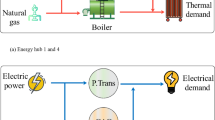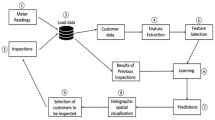Abstract
With the commitment to climate, globally many countries started reducing brownfield energy production and strongly opting towards green energy resources. However, the optimal allocation of distributed energy resources (DERs) in electrical distribution systems still pertains as a challenging issue to attain the maximum benefits. It happens due to the system’s complex behaviour and inappropriate integration of DERs that adversely affects the distribution grid. In this work, we propose a methodology for the optimal allocation of DERs with vulnerable node identification in active electrical distribution networks. A failure or extreme event at the vulnerable node would interrupt the power flow in the distribution network. Also, the power variation in these vulnerable nodes would significantly affect the operation of other linked nodes. Thus, these nodes are found suitable for the optimal placement of DERs. We demonstrate the proposed data-driven approach on a standard IEEE-123 bus test feeder. Initially, we partitioned the distribution system into optimal microgrids using graph theory and graph neural network architecture. Further, using Granger causality analysis, we identified vulnerable nodes in the partitioned microgrid, suitable for DERs integration. The placement of DERs on the vulnerable nodes enhanced network resilience. Improvement in resilience is validated by computing the percolation threshold for the microgrid networks. The results show a 37% improvement in the resilience of the system due to the optimal allocation of DERs.







Similar content being viewed by others
References
Sanchez, R., Santiago, L., Shah, K.: Power returning to puerto rico after massive outage caused by fallen tree [online, cited 2.09.2022]
Yuanyuan, Z., Yiran, A., Qian, A.: Research on size and location of distributed generation with vulnerable node identification in the active distribution network. IET Gen. Transm. Distrib. 8, 1801–1809 (2014)
Dwivedi, D., Victor, S.M.B.K., Yemula, P.K., Chakraborty, P., Pal, M.: Evaluation of energy resilience and cost benefit in microgrid with peer-to-peer energy trading. arXiv preprint arXiv:2212.02318 (2022)
Dwivedi, D., Yemula, P.K., Pal, M.: A methodology for identifying resiliency in renewable electrical distribution system using complex network. arXiv preprint arXiv:2208.11682 (2022)
Dou, C., Hu, L., Yue, D., Zhang, Z., Ding, X., Li, Y.: Active power distribution network vulnerable node identification method which considers new energy impact (2020). https://patents.google.com/patent/WO2022134596A1/en
Zhao, T., Xu, Y., Wang, Y., Lin, Z., Xu, W., Yang, Q.: On identifying vulnerable nodes for power systems in the presence of undetectable cyber-attacks. In: 2016 IEEE 11th Conference on Industrial Electronics and Applications (ICIEA), pp. 1062–1067 (2016)
Li, M., Li, S., Li, L., Jia, Y., Liu, X., Yang, Y.: Identifying vulnerable nodes of complex networks in cascading failures induced by node-based attacks. In: Mathematical Problems in Engineering. Hindawi Publishing Corporation (2013)
Huang, B., Li, J., Wang, J.: An evidential reasoning based approach to building node selection criterion for network reduction (2020). arXiv preprint arXiv: 2012.13684
Karatepe, E., Ugranlı, F., Hiyama, T.: Comparison of single- and multiple-distributed generation concepts in terms of power loss, voltage profile, and line flows under uncertain scenarios. Renew. Sustain. Energy Rev. 48, 317–327 (2015)
Dulău, L.I., Abrudean, M., Bică, D.: Effects of distributed generation on electric power systems. In: Procedia Technology, the 7th International Conference Interdisciplinarity in Engineering, INTER-ENG 2013, 10–11 October 2013, vol. 12, pp. 681–686. Petru Maior University of Tirgu Mures, Romania (2014)
Burtt, D., Dargusch, P.: The cost-effectiveness of household photovoltaic systems in reducing greenhouse gas emissions in Australia: linking subsidies with emission reductions. Appl. Energy 148, 439–448 (2015)
Saad, O., Abdeljebbar, C.: Historical literature review of optimal placement of electrical devices in power systems: critical analysis of renewable distributed generation efforts. IEEE Syst. J. 15(3), 3820–3831 (2021)
Taha, H.A., Alham, M.H., Youssef, H.K.M.: Multi-objective optimization for optimal allocation and coordination of wind and solar DGs, BESSs and capacitors in presence of demand response. IEEE Access 10, 16225–16241 (2022)
Singh, P., Meena, N.K., Slowik, A., Bishnoi, S.K.: Modified African buffalo optimization for strategic integration of battery energy storage in distribution networks. IEEE Access 8, 14289–14301 (2020)
Purlu, M., Turkay, B.E.: Optimal allocation of renewable distributed generations using heuristic methods to minimize annual energy losses and voltage deviation index. IEEE Access 10, 21455–21474 (2022)
Zheng, Y., Song, Y., Huang, A., Hill, D.J.: Hierarchical optimal allocation of battery energy storage systems for multiple services in distribution systems. IEEE Trans. Sustain. Energy 11(3), 1911–1921 (2020)
Fang, F., Zhu, Z., Jin, S., Hu, S.: Two-layer game theoretic microgrid capacity optimization considering uncertainty of renewable energy. IEEE Syst. J. 15(3), 4260–4271 (2021)
Huang, B., Wang, J.: Adaptive static equivalences for active distribution networks with massive renewable energy integration: a distributed deep reinforcement learning approach. IEEE Trans. Netw. Sci. Eng. 1–13 (2023)
Huang, B., Wang, J.: Deep-reinforcement-learning-based capacity scheduling for pv-battery storage system. IEEE Trans. Smart Grid 12(3), 2272–2283 (2021)
Lee, S.H., Park, J.-W.: Optimal placement and sizing of multiple DGS in a practical distribution system by considering power loss. IEEE Trans. Ind. Appl. 49(5), 2262–2270 (2013)
Kizito, R., Li, X., Sun, K., Li, S.: Optimal distributed generator placement in utility-based microgrids during a large-scale grid disturbance. IEEE Access 8, 21333–21344 (2020)
Vugrin, E., Andrea, C.D.R., Silva-Monroy, C.A.: Resilience metrics for the electric power system: a performance-based approach, United States, p. 2017 (2017)
Phillips, T., McJunkin, T., Rieger, C., Gardner, J., Mehrpouyan, H.: An operational resilience metric for modern power distribution systems. In: 2020 IEEE 20th International Conference on Software Quality, Reliability and Security Companion (QRS-C), pp. 334–342 (2020)
Chanda, S., Srivastava, A.K., Mohanpurkar, M.U., Hovsapian, R.: Quantifying power distribution system resiliency using code-based metric. IEEE Trans. Ind. Appl. 54(4), 3676–3686 (2018)
Poudel, S., Dubey, A., Bose, A.: Risk-based probabilistic quantification of power distribution system operational resilience. IEEE Syst. J. 14(3), 3506–3517 (2020)
Kandaperumal, G., Pandey, S., Srivastava, A.: AWR: anticipate, withstand, and recover resilience metric for operational and planning decision support in electric distribution system. IEEE Trans. Smart Grid 13(1), 179–190 (2022)
Mohamed, M.A., Chen, T., Su, W., Jin, T.: Proactive resilience of power systems against natural disasters: a literature review. IEEE Access 7, 163778–163795 (2019)
Blagojević, N., Hefti, F., Henken, J., Didier, M., Stojadinović, B.: Quantifying disaster resilience of a community with interdependent civil infrastructure systems. Struct. Infrastruct. Eng. 0(0), 1–15 (2022)
Newman, M.: Networks: An Introduction. Oxford University Press (2010)
Stockmayer, W.H.: Theory of molecular size distribution and gel formation in branched polymers II. General cross linking. J. Chem. Phys. 12, 125–131 (1944)
Hammersley, J.M., Handscomb, D.C.: Percolation Processes, pp. 134–141. Springer, Dordrecht (1964)
Blanc, R.: Introduction to Percolation Theory, pp. 425–478. Springer, Dordrecht (1986)
Granger, C.W.J.: Investigating Causal Relations by Econometric Models and Cross-Spectral Methods, Volume 2 of Econometric Society Monographs, pp. 31–47. Cambridge University Press (2001)
Lin, F.-H., Hara, K., Solo, V., Vangel, M., Belliveau, J., Stufflebeam, S., Hamalainen, M.: Dynamic Granger–Geweke causality modeling with application to interictal spike propagation. Neuroimage 47, S169 (2009). (organization for Human Brain Mapping 2009 Annual Meeting)
Yuan, Q., Jiang, T.: Brain efficient connectivity analysis of attention based on the granger causality method. J. Biomed. Eng. 33, 56–60 (2016)
Rodriguez-Rivero, J., Ramirez, J., Martínez-Murcia, F., Segovia, F., Ortiz, A., Salas, D., Castillo-Barnes, D., Illan, I., Puntonet, C., Jimenez-Mesa, C., Leiva, F., Carillo, S., Suckling, J., Gorriz, J.: Granger causality-based information fusion applied to electrical measurements from power transformers. Inform. Fusion 57, 59–70 (2020)
Guo, J., Hug, G., Tonguz, O.K.: Intelligent partitioning in distributed optimization of electric power systems. IEEE Trans. Smart Grid 7(3), 1249–1258 (2016)
Sánchez-García, R.J., Fennelly, M., Norris, S., Wright, N., Niblo, G., Brodzki, J., Bialek, J.W.: Hierarchical spectral clustering of power grids. IEEE Trans. Power Syst. 29(5), 2229–2237 (2014)
Cotilla-Sanchez, E., Hines, P.D.H., Barrows, C., Blumsack, S., Patel, M.: Multi-attribute partitioning of power networks based on electrical distance. IEEE Trans. Power Syst. 28(4), 4979–4987 (2013)
Brandes, U., Delling, D., Gaertler, M., Gorke, R., Hoefer, M., Nikoloski, Z., Wagner, D.: On modularity clustering. IEEE Trans. Knowl. Data Eng. 20(2), 172–188 (2008)
Scarselli, F., Gori, M., Tsoi, A.C., Hagenbuchner, M., Monfardini, G.: The graph neural network model. IEEE Trans. Neural Netw. 20(1), 61–80 (2009)
Chen, K., Hu, J., Zhang, Y., Yu, Z., He, J.: Fault location in power distribution systems via deep graph convolutional networks. IEEE J. Sel. Areas Commun. 38(1), 119–131 (2020)
He, J., Zhao, H.: Fault diagnosis and location based on graph neural network in telecom networks. Int. Conf. Network. Network Appl. 2020, 304–309 (2020)
Wu, H., Wang, M., Xu, Z., Jia, Y.: Graph attention enabled convolutional network for distribution system probabilistic power flow. IEEE Trans. Ind. Appl. 58(6), 7068–7078 (2022)
Cavanaugh, J.E., Neath, A.A.: The Akaike information criterion: Background, derivation, properties, application, interpretation, and refinements. WIREs Comput. Stat. 11(3), e1460 (2019)
Profillidis, V., Botzoris, G.: Chapter 6—Trend projection and time series methods. In: Modeling of Transport Demand, pp. 225–270. Elsevier (2019)
Mallala, B., Dwivedi, D., Venkata, G., Sowjan Kumar, K.: Optimal power flow solution with current injection model of generalized interline power flow controller using ameliorated ant lion optimization. Int. J. Electr. Comput. Eng. 13, 1060 (2023)
Radicchi, F.: Predicting percolation thresholds in networks. Phys. Rev. E 91, 010801 (2015)
Acknowledgements
Divyanshi Dwivedi and D. Maneesh Reddy would like to thank ABB Ability Innovation Centre, Hyderabad, for the financial support in research. The author Mayukha Pal would like to thank the ABB Ability Innovation Center, Hyderabad, for their support in this work.
Author information
Authors and Affiliations
Contributions
DMR helped in methodology, software, writing—original draft. DD was involved in methodology, software, data curation, writing—original draft. PKY contributed to supervision, writing—reviewing and editing. MP was involved in conceptualization, methodology, project administration, validation, supervision, writing—reviewing and editing.
Corresponding author
Ethics declarations
Conflict of interest
The authors declare that they have no known competing financial interests or personal relationships that could have appeared to influence the work reported in this paper.
Additional information
Publisher's Note
Springer Nature remains neutral with regard to jurisdictional claims in published maps and institutional affiliations.
Rights and permissions
Springer Nature or its licensor (e.g. a society or other partner) holds exclusive rights to this article under a publishing agreement with the author(s) or other rightsholder(s); author self-archiving of the accepted manuscript version of this article is solely governed by the terms of such publishing agreement and applicable law.
About this article
Cite this article
Reddy, D.M., Dwivedi, D., Yemula, P.K. et al. Data-driven approach to form energy-resilient microgrids with identification of vulnerable nodes in active electrical distribution network. Int J Data Sci Anal (2023). https://doi.org/10.1007/s41060-023-00430-8
Received:
Accepted:
Published:
DOI: https://doi.org/10.1007/s41060-023-00430-8




